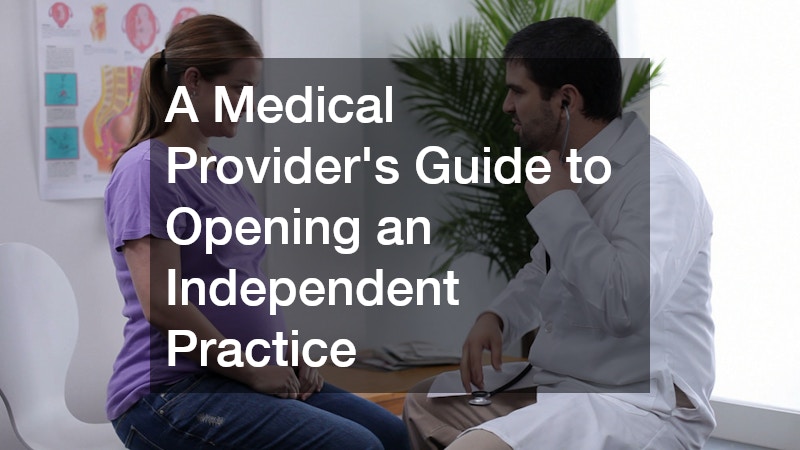A Medical Providers Guide to Opening an Independent Practice
Starting an independent medical practice is a significant step toward professional freedom and community impact. It allows healthcare providers to create a patient experience that aligns with their values, expertise, and long-term goals. However, opening a practice requires careful planning, strategic investment, and attention to both business operations and patient care. From choosing the right location to ensuring regulatory compliance, each decision plays a critical role in establishing a successful medical facility. With proper preparation and professional support, providers can build a strong foundation that supports growth, fosters trust, and delivers quality care to every patient who walks through the door.
Establishing a Strong Foundation for Your New Practice
Before launching your independent practice, it’s essential to build a clear vision and a solid operational plan. This includes defining your target patient demographic, choosing your medical specialties, and determining the range of services you’ll provide. Establishing a strong foundation also involves creating a business plan that outlines projected costs, revenue goals, and marketing strategies. By setting clear objectives early, you can make informed decisions and reduce the likelihood of financial or logistical setbacks. A well-structured plan ensures your practice begins with purpose and clarity, setting the stage for long-term success.
For specialists like a local podiatrist, this process may involve additional considerations such as equipment selection, patient accessibility, and compliance with healthcare regulations. Podiatrists, for example, must ensure their facilities have specialized treatment chairs, sterilization areas, and proper sanitation stations. Developing a detailed timeline for equipment purchases, credentialing, and staff hiring can help the setup process run smoothly. Working with medical consultants or industry experts can also help refine your practice structure to align with state and federal standards. With proper planning and attention to detail, you’ll be ready to open your doors with confidence and provide care that reflects your professional expertise.
Choosing the Right Location and Facility for Patient Care
The success of your medical practice often depends heavily on its location. The right facility not only affects visibility and patient accessibility but also influences operational efficiency and comfort. When selecting a location, consider factors such as proximity to other healthcare providers, population density, parking availability, and nearby amenities. The facility itself should have adequate space for waiting areas, exam rooms, staff offices, and specialized medical equipment. A well-designed and conveniently located office enhances patient satisfaction and helps your practice grow through word-of-mouth referrals.
Finding a local doctor office that meets your practice’s needs can make the transition from planning to opening much smoother. Leasing or purchasing an existing medical space can save both time and money, as many facilities are already equipped with essential features such as reception areas and accessible restrooms. However, it’s still important to assess the building’s condition, compliance with ADA requirements, and zoning regulations. Working with a real estate agent who specializes in healthcare properties can help you secure a space that aligns with your budget and long-term goals. The right location sets the tone for your practice’s success by providing patients with a comfortable, accessible, and welcoming environment.
Managing Finances and Insurance With Proper Training
Financial management is one of the most critical components of launching and maintaining a successful medical practice. From setting up your billing system to managing patient insurance claims, your practice’s financial health directly affects its sustainability. Understanding how to handle insurance claims efficiently helps ensure that your revenue stream remains consistent and reliable. Many new practice owners underestimate the complexity of healthcare billing, which can lead to delays in payments or compliance issues. Having the right financial processes in place from the start ensures your practice remains organized, transparent, and profitable.
Taking a medical insurance billing and coding course is an excellent way to gain the foundational knowledge needed to manage patient claims and understand reimbursement procedures. Such training covers essential topics like CPT and ICD-10 coding, insurance verification, and billing system management. Whether you plan to handle billing in-house or outsource it to a third-party service, understanding how these systems operate helps prevent costly errors. A solid grasp of billing and coding also ensures compliance with state and federal healthcare regulations. Investing time in this training ultimately saves money and helps your independent practice maintain financial stability as it grows.
Creating an Inviting and Professional Outdoor Environment
Your practice’s exterior appearance makes a lasting first impression on patients and visitors. A well-maintained outdoor area communicates professionalism, care, and attention to detail—qualities that patients expect from healthcare providers. From clean walkways to well-placed greenery, the landscaping around your facility plays an important role in creating a welcoming environment. Beyond aesthetics, outdoor maintenance also contributes to safety and accessibility by reducing slip hazards and keeping pathways clear.
Hiring a commercial landscaper ensures your facility’s grounds remain attractive and safe throughout the year. These professionals can design and maintain landscaping that complements your building’s architecture while adhering to local regulations. They can also implement irrigation systems, seasonal plantings, and signage displays that enhance your property’s visibility. A well-cared-for landscape creates a calming atmosphere for patients, especially those who may feel anxious about visiting a medical office. By investing in quality landscaping, you elevate the overall experience and create an environment that supports your practice’s image and reputation.
Ensuring Safety and Compliance Through Security Systems
Security should be a top priority for any new medical facility. Protecting patient data, equipment, and staff requires a robust security strategy that goes beyond simple locks and alarms. Modern security systems can help monitor activity, prevent unauthorized access, and provide documentation in the event of an incident. In healthcare, compliance with privacy laws such as HIPAA also makes it essential to control who can access sensitive areas and information. Implementing the right safety systems builds patient trust and protects your business from potential risks.
Installing access control systems gives you greater control over who enters different areas of your practice. These systems can include keycard entry, biometric scanners, or keypad locks that restrict access to offices, medication storage, or record rooms. Access control also helps track employee activity, ensuring accountability and enhancing workplace security. Integrating these systems with video surveillance can provide comprehensive protection while maintaining compliance with patient privacy standards. Prioritizing security early in your setup not only safeguards your investment but also demonstrates professionalism and responsibility to your patients and staff.
Maintaining Reliable and Sanitary Infrastructure
Every medical practice relies on a functional and hygienic infrastructure to operate smoothly. Plumbing is one of the most essential components of any facility, ensuring access to clean water for handwashing, sanitation, and patient care. Faulty plumbing can quickly lead to operational issues, health code violations, or even property damage. Establishing a reliable plumbing system from the beginning helps maintain a safe and professional environment for both patients and staff. Regular inspections, maintenance, and upgrades are also key to preventing disruptions and costly repairs.
Partnering with experienced professionals who provide plumbing services ensures your medical practice remains compliant with safety and health standards. These specialists can design and install plumbing systems that meet the specific needs of healthcare facilities, such as sterilization sinks, patient restrooms, and medical-grade water lines. They can also handle maintenance tasks like leak detection, pipe repair, and water pressure optimization. A proactive approach to plumbing helps ensure uninterrupted operations, preventing inconveniences that could negatively impact patient experiences or scheduling. Keeping your facility in top working order reinforces the professionalism and care your practice strives to provide.
Enhancing Visibility and Curb Appeal for Your Practice
Your medical practice’s exterior plays a key role in attracting patients and establishing your brand identity. A building that is visually appealing, easy to find, and well-maintained signals quality and reliability to potential patients. Design elements like awnings, signage, and exterior lighting can make a significant difference in how your facility is perceived. These details not only improve curb appeal but also provide practical benefits, such as protection from weather and increased energy efficiency. Investing in the exterior design of your building helps your practice stand out and feel more approachable to the community.
Adding a commercial awning is one effective way to elevate your building’s exterior while providing comfort and function. Awnings can shade windows, reduce heat inside your office, and create an inviting entrance for patients. They can also serve as a branding opportunity by displaying your logo or color scheme. Professional installers can help you select materials and styles that complement your building’s architecture while offering durability against the elements. The right awning enhances both aesthetics and functionality, leaving a strong impression on patients as they approach your facility.
Refreshing Your Interior and Exterior for a Welcoming Look
The interior and exterior appearance of your medical practice directly influence how patients feel when they enter your space. Clean, modern, and well-maintained spaces create an atmosphere of professionalism and comfort. Over time, walls, trim, and surfaces can become worn, making the environment feel dated or uninviting. Regularly updating paint and finishes keeps your facility looking fresh and helps maintain a positive first impression. Creating an environment that feels calm and clean encourages patients to trust your practice and return for future care.
Hiring a professional painting contractor ensures your office receives a high-quality finish that aligns with your brand and atmosphere. These experts can recommend colors that promote relaxation and confidence, such as soft blues, greens, or neutral tones. They also handle surface preparation and use durable, low-VOC paints ideal for medical environments where air quality and cleanliness are top priorities. Regular painting not only enhances your aesthetic but also protects surfaces from wear and damage. Investing in these updates demonstrates your attention to detail and commitment to maintaining a safe, inviting space for everyone who visits your practice.
Regulating Comfort and Air Quality for Patients and Staff
A comfortable and healthy indoor environment is essential for both patient satisfaction and staff productivity. Air quality, temperature control, and ventilation all play a significant role in creating a safe and pleasant atmosphere. Poor air circulation or inconsistent temperatures can make patients uncomfortable and lead to issues such as fatigue, headaches, or even worsened symptoms for those with respiratory conditions. Ensuring your HVAC system is reliable and efficient helps maintain optimal comfort levels while reducing energy costs and improving overall air quality.
Working with an experienced HVAC contractor allows your practice to design and maintain a system that meets the specific needs of medical facilities. These professionals can assess your building’s size, layout, and insulation to determine the best equipment and airflow design. They can also provide regular maintenance to prevent breakdowns and ensure filters are replaced on schedule to reduce allergens and contaminants. Proper HVAC care not only enhances comfort but also supports infection control and energy efficiency. By investing in the right HVAC system, you create an environment that keeps patients relaxed and your team focused on delivering exceptional care.
Streamlining Communication and Technology Systems
In today’s healthcare landscape, efficient communication systems are essential for smooth operations and quality patient care. Whether it’s coordinating appointments, handling emergencies, or managing patient inquiries, reliable communication tools can make or break your practice’s workflow. Outdated systems can lead to missed calls, delayed responses, and frustrated patients. Investing in modern communication infrastructure ensures your team stays connected and your patients receive timely support.
Implementing a business voip system offers flexibility, cost savings, and professional functionality for your independent practice. These systems use internet-based calling, allowing you to integrate features like voicemail-to-email, call forwarding, and automated appointment reminders. Many VoIP platforms can also connect with your electronic medical record (EMR) system to streamline communication between staff and patients. With the right setup, your practice can reduce missed appointments and improve efficiency across departments. By upgrading your communication systems, you reinforce reliability and professionalism while creating a seamless experience for everyone involved.
Opening an independent medical practice is one of the most rewarding milestones a healthcare professional can achieve. However, success requires more than just medical expertise—it takes thoughtful planning, reliable infrastructure, and a patient-first mindset. From selecting the right location and designing a comfortable environment to investing in top-quality plumbing, HVAC, and communication systems, every decision plays a part in shaping your reputation and long-term success. A well-prepared practice reflects the same care and precision that you provide to your patients, building confidence from the moment they arrive.
By partnering with trusted contractors, maintaining your facility, and prioritizing efficiency, you can create a space that operates smoothly and reflects your commitment to excellence. An independent practice is not just a place of work—it’s a reflection of your dedication to improving lives through compassionate, high-quality healthcare. With the right foundation and ongoing attention to detail, your practice can thrive as a respected and trusted part of your community for years to come.





